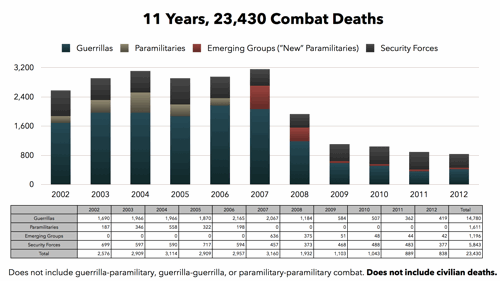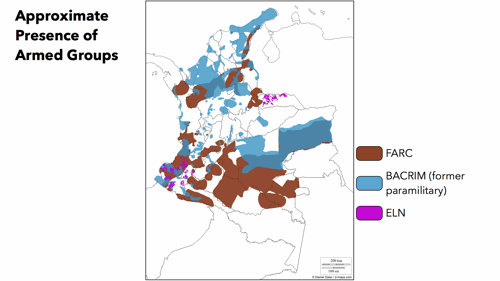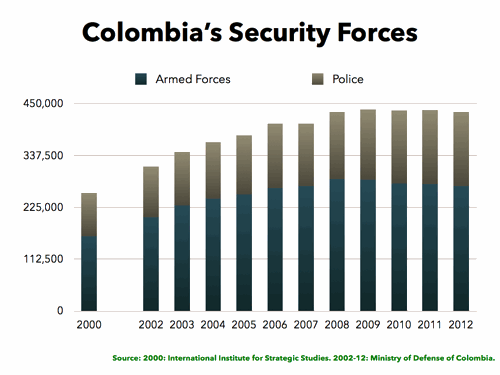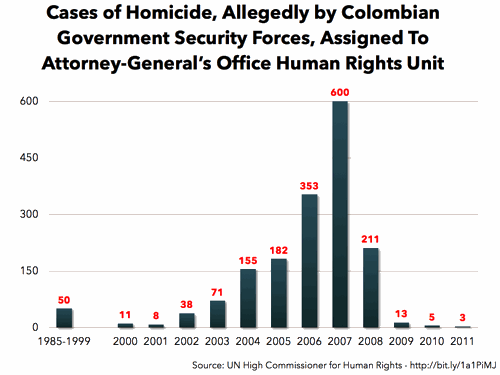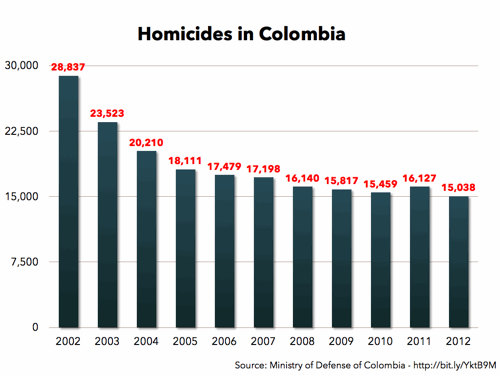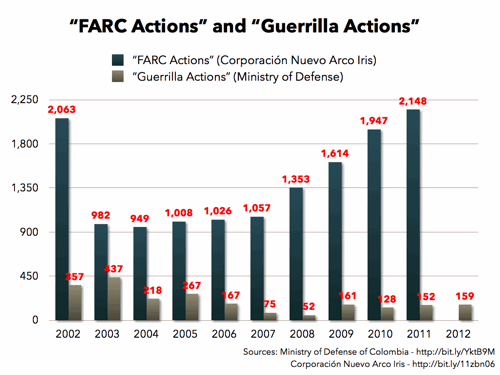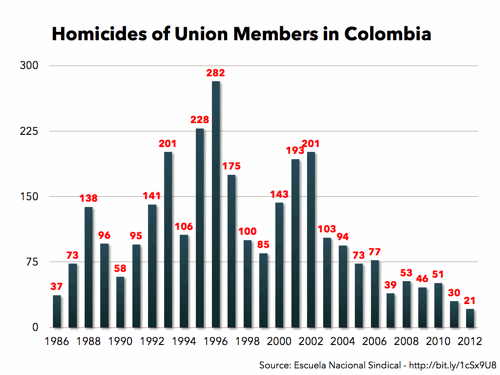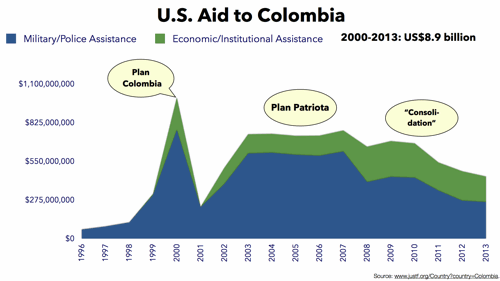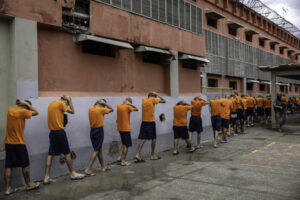The Human Rights Landscape in Colombia
Written Testimony of Adam Isacson, Senior Associate for Regional Security Policy, Washington Office on Latin America
Hearing of Tom Lantos Human Rights Commission: “Creating Peace and Finding Justice in Colombia,” United States Congress, October 24, 2013
Download “The Human Rights Landscape in Colombia” in printable PDF format (1.4 MB)
Colombia’s armed conflict killed 218,094 people between 1958 and 2012. Over 81 percent of them were civilians. Since 1985, explains a government-sponsored Historical Memory Center’s July 2013 report, 25,007 more Colombians were forcibly “disappeared,” and 5,712,506—almost 15 percent of the country—were displaced by violence.[1]
Colombia, Latin America’s third most-populous country, is the only place in the Western Hemisphere where an armed conflict pits a government against violent armed groups with national reach and political demands. Even though 2012 was one of the least violent years of the past 20, combat still killed 827 members of the security forces and illegal armed groups.[2] The fighting, and related political violence, most likely killed a similar or larger number of civilians.
Guerrillas
High levels of violence have been a constant at least since 1948. The two principal guerrilla groups active today date back to 1964, making Colombia’s the oldest conflict in the world causing more than 1,000 deaths per year. Together, guerrillas are responsible for about 20 percent of all civilian non-combatants killed in the conflict.[3] Guerrillas lay the vast majority of anti-personnel mines, a practice that has killed or wounded 10,189 people since 1988 and that the armed forces have ceased to employ.[4] Guerrillas actively recruit minors; 20 to 30 percent of their membership, perhaps more, is believed to be less than 18 years old.[5]
The Revolutionary Armed Forces of Colombia (FARC) was founded in 1964 by radicalized smallholding farmers with links to the Communist Party. The FARC operates in about 23 percent of the country’s municipalities (counties), and is most present in border zones, along the Pacific coast, and in its oldest stronghold, the sparsely populated plains and jungles of south-central Colombia.[6] It is Colombia’s largest guerrilla group with approximately 7,000 or fewer members, down from a height of at least 18,000 a decade ago.[7] It funds itself mainly through narcotrafficking, illegal mining, and extortion.
The National Liberation Army (ELN) was founded in 1964 by radicalized students and Catholic clergy inspired by the 1959 Cuban revolution. It is smaller than the FARC—perhaps 2,000 members—and is strongest in the Arauca oil-producing region near the Venezuelan border, a north-central region known as Magdalena Medio, and in a few municipalities in the far southwest. The ELN participated less in the drug trade than the FARC, at least until recently, and pioneered kidnapping for ransom as a way to fund itself.
Kidnapping
The ELN and FARC, along with other, now defunct, leftist guerrillas, carried out over 90 percent of the 27,023 kidnappings for ransom that the Historical Memory Center counted in Colombia since 1970.[8] Kidnapping remains a frequent crime, though it happens far less than it did a decade ago. According to Colombia’s Defense Ministry, 305 people were kidnapped in 2012, compared with 2,882 in 2002, and common criminals abducted most of the 2012 number.[9] The sharp decline in guerrilla kidnappings owes to the Colombian security forces’ improved mobility, allowing them to respond quickly after they occur; their improved intelligence to find people held hostage; and the guerrillas’ own decision to limit the practice because of the high level of rejection it generates within society.
The Free Country Foundation, a Colombian NGO that tracks kidnapping trends, estimated that 1,083 people were being held hostage at the end of 2012, though it is sadly likely that most have in fact died in captivity.[10] The ELN continues to kidnap a small number of civilians, while the FARC claims that it renounced the practice to meet a government pre-condition for starting peace talks in mid-2012.
The FARC is currently holding a U.S. citizen who, in June 2013, traveled alone deep into Colombia’s southern jungles. The guerrillas say they are willing to release Kevin Scott Sutay as a goodwill gesture, but Colombian President Juan Manuel Santos has so far refused their release conditions on grounds that they would cause a “media show.”
Peace Talks
The talks between the FARC and the government, which formally launched in Oslo, Norway on October 18, 2012, began their sixteenth round on October 23, 2013. Each round has taken about ten days, and all but the first took place in Havana, Cuba. This is the fourth time in the past thirty years that the Colombian government and the FARC have held formal dialogues to seek an end to the conflict. Government and FARC negotiators are following a six-point agenda covering five policy issues (land, political participation, transitional justice, drug policy, victims) plus implementation details. While ambitious, the agenda does not touch core themes like Colombia’s economic model, foreign investment, or defense and security policy. The two sides are negotiating without a cease-fire in place, at the Colombian government’s insistence, and both continue to launch attacks on a daily basis.
In late May, the negotiators reached unprecedented agreement on the first agenda item, land and rural development, an issue of central importance to the rurally based FARC. Since then, though, six rounds of talks have failed to bring agreement on the second agenda item, guarantees for the political opposition (which would presumably include a disarmed FARC acting as a political party). The guerrillas are insisting on a constitutional convention to cement in place a future peace accord, while the government proposes a simple public referendum. Talks currently appear to be stuck on this issue. While polls show a clear majority of Colombians supporting the idea of negotiating with the FARC, public opinion is also growing more pessimistic as the talks’ pace slows.[11]
The month of November will be critical, as it marks the beginning of the campaign season for Colombia’s March 2014 legislative elections and May 2014 presidential elections. Candidates must officially declare their candidacies, and the ensuing campaign is likely to create both uncertainty and distraction that could halt progress at the negotiating table. In November, the negotiators may decide to freeze the talks until after the elections, to attempt to continue dialogue during the campaign, or to call off the peace process entirely.
Transitional Justice
Should the Havana negotiators manage an agreement on the second agenda item, they move to the third, “Ending the Conflict.” The central issue here will be transitional justice: what kind of arrangement will allow guerrillas to demobilize and rejoin civilian life, while still holding them accountable for violating non-combatants’ human rights.
In June 2012, Colombia’s Congress passed a constitutional amendment that sets the parameters for transitional justice. The “Legal Framework for Peace,” upheld by the country&rsqu
o;s Constitutional Court in August 2013, includes language making possible reduced or even suspended sentences for even the worst rights violators. Whatever arrangement emerges from this framework will result from an enabling law, the contents of which would be negotiated in Havana. Suspended sentences are unlikely, however. This is because Colombia’s is the first peace process in the world to involve a party to the International Criminal Court. The Court could intervene if it determines that Colombia has not sufficiently punished those responsible for crimes against humanity.
A likely outcome is that demobilized guerrillas accused of committing lesser crimes would receive suspended sentences or even amnesty in exchange for a full confession of their crimes and reparations to victims. Colombia’s judicial system does not have the capacity to try tens of thousands of guerrilla crimes. But Colombia’s international commitments make it impossible to suspend sentences for those responsible the most serious crimes. The number of guerrilla leaders and fighters who may face such charges would likely be in the low hundreds.
The conundrum, then, is how to convince top FARC leaders to turn in their weapons, demobilize their fighters—and proceed, if not to prison, then to some sort of arrangement that deprives them of liberty for a specific period of time. This may not be an impossible task: if demobilized FARC leaders truly abandon criminality, they will have no immediate means to support themselves, and their long list of potential enemies would make them very hard to protect if they were out in public. A few years of confinement under police guard, in which they could meet with interlocutors and build their political movement but could not leave the premises, might be appropriate—provided it came with full confessions of deeds, turnover of illegally acquired assets, and reparations to victims.
The Colombian government did something similar with pro-government paramilitary groups that demobilized between 2003 and 2006, though most of the worst violators were placed in regular, not alternative, prisons. This so-called “Justice and Peace Process,” though, showed the shortcomings of Colombia’s judicial system, which proved under-equipped for a wave of serious human rights cases, even within a transitional justice framework allowing for reduced sentences. Of the 31,849 demobilized members of the United Self-Defense Forces of Colombia (AUC) paramilitary network, 4,237 have faced human rights charges so serious that they entered the Justice and Peace process beginning in 2005.[12] Eight years later, Justice and Peace trials have yielded only 14 verdicts.[13] Trials continue to drag on for the rest. About 30 paramilitary leaders have been extradited to the United States to face narcotrafficking charges.[14] Dozens of FARC leaders face similar charges in U.S. courts, and will not demobilize unless a peace agreement specifically prohibits their extradition to the United States.
State Security Forces
The peace framework law also applies to members of Colombia’s armed forces and police. Post-conflict transitional justice could see similarly light sentences or alternative confinement for members of the security forces accused of committing grave human rights abuses. This did not happen in Colombia’s early 1990s peace processes, in which smaller guerrilla groups’ demobilized members were amnestied but soldiers and police were not. Colombia’s military is determined not to let that happen again—and it has more clout now than it did twenty years ago.
Since 2000, Colombia’s armed forces have grown from about 180,000 to 280,000 members, and its police have grown from about 101,000 to 173,000 since 2002.[15] Colombia now has the largest army in Latin America (232,000), though Brazil’s total armed forces are still larger than Colombia’s. Colombia’s defense budget has roughly tripled, in dollar terms, since 2000.[16] Because of recent battlefield successes, opinion polls also show the armed forces to be one of the country’s most popular institutions.
Should a Framework for Peace “enabling law” allow military personnel to receive transitional justice benefits, hundreds of human rights abuse cases could be transferred to a system that (depending on the severity of the crime) gives soldiers amnesty or light sentences similar to those given to the worst ex-guerrilla violators, instead of the maximum 40 years’ imprisonment that they would face today. Though such a process would likely include confessions and reparations, victims of military abuses might be unhappy with the prospect of soldiers avoiding regular criminal justice for committing two especially pervasive sets of crimes.
“False Positives”
The first of these are extrajudicial executions of innocent civilians, a practice that worsened dramatically between 2002 and 2008. Basing itself on statistics from Colombia’s civilian Attorney-General’s Office, the UN High Commissioner for Human Rights cited 1,708 cases of civilians killed by the security forces, chiefly the Army, involving over 4,000 victims. Of these cases, over 95 percent occurred between 2002 and 2008.[17]
Many of the military’s victims during the 2002-2008 period were what have come to be known as “false positives.” Soldiers stand accused of abducting civilians—or even paying criminal groups to abduct them—then killing them and presenting their bodies as those of armed-group members killed in combat. During this period, military personnel were receiving both moral and material rewards for high body counts. While the UN and human rights groups had been warning publicly of the rise in “false positives” since at least early 2004, the practice did not halt until the September 2008 revelation that more than a dozen men missing from a poor Bogotá suburb had been lured with the promise of employment, taken hundreds of miles away, killed, and presented as dead combatants.
After this scandal broke, incentives were mostly changed, and alleged extrajudicial killings have fallen to the low double digits. In 2012, the UN High Commissioner’s Office—whose field office in Bogotá continues to play an absolutely essential monitoring role—“received no reports of military killings having the purpose of increasing statistics” of body counts.[18] The human rights group CINEP, which maintains a database of human rights violations, counted 11 cases of “false positives,” with 12 victims, in 2012; Colombia’s Defense Ministry disputed CINEP’s use of the term.[19]
Meanwhile thousands of cases of “false positives” and other extrajudicial executions continue to move slowly through Colombia’s justice system (principally the civilian justice system, though as discussed below, there is concern that could change). “Of all homicide investigations” against the security forces, the UN High Commissioner reported in early 2013, “only 30 percent report procedural activity. Of these active cases, the great majority has not passed the preliminary criminal investigation stage.” The State Department reported in September 2013 that, during the first 11 months of 2012, civilian courts convicted 589 military and police personnel for 192 ca
ses of extrajudicial executions committed since 2000.[20]
Aiding and Abetting Paramilitary Groups
Over the course of the conflict, Colombia’s security forces have been directly responsible for about 10 percent of all non-combatant killings.[21] Between about 1996 and 2002, though, the military and police share of total civilian killings fell below that level, as paramilitary groups went on a nationwide rampage.[22] Once the AUC paramilitary group demobilized and reduced its activity in the early to mid-2000s, the number of direct abuses committed by soldiers—mainly extrajudicial executions—increased, reaching about half of the overall total in 2007.[23]
Before those demobilizations, during the period of greatest paramilitary activity, the AUC committed the vast majority of civilian killings: between 70 and 80 percent, according to the Historical Memory Center and major Colombian human rights groups.[24] When the AUC was at its worst, especially during the 1999-2002 period, the paramilitary organization carried out more than 100 massacres (defined as the killing of four or more non-combatants in a single event) each year.
The Colombian armed forces’ low share of abuses during the peak paramilitary period is deceptive. In many cases, paramilitary groups benefited from material, logistical, planning, and intelligence support from military and police personnel. In some cases, officers stand accused of helping to plan paramilitary massacres and other actions against the civilian cases. More often, they are accused of deliberate negligence: failing to act to prevent paramilitary massacres, or to respond to calls for help. “The omission of information, collusion, logistical support to the perpetrators, or the disguising of their own actions are some of the ways members of the security forces have been implicated in facilitating the occurrence of massacres,” reads the Historical Memory Center report.[25]
Today, civilian courts have convicted dozens of military personnel, including a handful of generals and colonels, for past collaboration with paramilitary groups. However, Colombia’s security forces have yet to come to terms with the breadth of their relationship with individuals accused of some of the most brutal abuses committed in Colombia’s conflict, along with the theft of millions of acres of land and the shipment of hundreds of tons of cocaine to the United States.
Paramilitary Groups Today
In 2002, newly elected President Álvaro Uribe made clear that he would negotiate demobilization terms with any armed group that first declared a cease-fire. The AUC quickly agreed, and the result was the Justice and Peace process and the demobilizations of nearly 32,000 people claiming to be paramilitary members.
A handful of paramilitary units refused to demobilize. Some lower and mid-level paramilitaries—rough estimates run from about 1,000 to 2,000 of them—fell back into armed activity as members of new, drug-funded militias. These new paramilitaries, which Colombian authorities call “criminal bands” or BACRIM, number somewhere between 3,000 and 5,000 members, and operate in between 21 and 31 percent of Colombia’s municipalities.[26] The most frequently used names are “Urabeños,” “Rastrojos,” “Paisas” and several smaller groups, but even when a name is heard in several corners of the country, their members do not appear to respond to a national command.
Many of these new groups concentrate on narcotrafficking, maintaining control over drug production and transshipment corridors. Some resemble urban street gangs, while others claim to be counter-insurgent armies. Nearly all make money from extortion as well as trafficking. They often fight each other, and some do business, particularly drug-trafficking business, with the leftist guerrillas. While they generate much violence and abuse human rights constantly, their brutality has not reached the scale of the old AUC. Some are used as muscle by landowners and corrupt politicians to threaten and kill local activists and human rights defenders—including dispossessed farmers petitioning for return of stolen land.
Rooting Out Paramilitarism
Like the old paramilitaries, the BACRIM thrive by developing relations with government officials, members of the security forces, and members of the business and landowning communities. Unlike the old AUC, these relationships are usually based more on corruption and illegal enrichment than on shared dedication to a cause like counter-insurgency. Also unlike the AUC, these relationships are not believed to reach the highest levels of government and security institutions in Bogotá, though they may be widespread in rural areas and smaller cities.
In those regions, a true end to Colombia’s conflict will mean confronting the nexus of local political bosses, large landowners, narcotraffickers, factions of the security forces, corrupt judicial and land-registry officials, and others who aided and abetted the rise of paramilitarism and massive theft of land in the 1990s and 2000s, and who continue to collude with the “new” paramilitaries in the 2010s. This will not be easy. A series of judicial investigations into local politicians’ ties with the AUC, known as “para-politics,” led to investigations, trials, or convictions of about 190 members of Colombia’s Congress, governors, mayors, and other local officials since 2006.[27] But para-politicians’ cronies, and even family members, remain in power in many regions, and investigations have barely scratched the surface of the relationships between paramilitaries—old and new—and members of the security forces or “para-economic” businessmen and landowners.
Recent Progress on Security and Rights
Colombia’s panorama is one of a bewilderingly complex conflict between a shifting, at times overlapping set of armed groups and often-unaccountable institutions. But the news is not all bad.
In fact, Colombia in the past ten years has seen a steeper drop in most measures of violence than any other Latin American country. The growth in the security forces’ capabilities reduced guerrilla groups’ ability to operate, especially in populated areas, bringing the reduction in kidnappings discussed above. Increased interdiction and regular captures of “kingpins” have reduced narcotraffickers’ power, wealth, and deadliness. While it didn’t eliminate paramilitarism, the AUC demobilization brought an important drop in these groups’ ability to kill, displace, and intimidate.
Homicides are down by 48 percent, from 28,837 in 2002 to 15,038 in 2012.[28] Colombia’s murder rate is now lower than Venezuela’s and about the same as Guatemala’s. At least 256,590 Colombians were forcibly displaced by violence last year; while still horrifyingly high, it is an important reduction from the 412,553 who were displaced in 2002.[29] Guerrilla groups are roughly half the size they were a decade ago, and the BACRIM are significantly smaller than the old AUC. Numerous top leaders of both FARC and BACRIM, including some of the most violent, have been removed from the scene in the past five years. Cultivation of coca, the plant used to make cocaine, has dropped to levels not seen since 1997.
With the steep decline in “false positives,” human rights abuses directly attributable to the security forces, while still too high, are at th
eir lowest point since documentation began in earnest in the late 1970s. While Colombia remains a dangerous place to be a labor organizer, killings of union members have dropped from 186 in 2002 to 20 last year.[30] Killings and threats of journalists are higher than in most of Latin America, but reduced, and the Colombian government has not passed measures to restrict media like governments in Venezuela or Ecuador. Scandals during the second half of the 2000s revealed, however, that journalists have been a frequent target of intelligence services’ illegal surveillance and wiretapping. Despite these obstacles, media—especially print media outlets in large cities—perform a good deal of groundbreaking investigative reporting.
Colombia’s current government, meanwhile, has demonstrated some good intentions on human rights (though the picture becomes cloudier in the discussion of military justice on page 15). The administration of Juan Manuel Santos has strengthened the Interior Ministry’s Protection Unit, which provides security for threatened human rights defenders, labor leaders, and others. It re-established a Ministry of Labor to improve vigilance over labor rights. In 2011, Santos worked with Colombia’s Congress to pass a landmark law to indemnify conflict victims and restitute stolen land to tens of thousands of dispossessed farmers. And he has staked a great deal of political capital—even his re-election prospects—on the current effort to negotiate peace with the FARC.
Good intentions only go so far, however. The ability to execute—to implement ambitious policies for extending justice, victims’ rights, and the rule of law to poorly governed parts of the country—is even more important, especially if Colombia is to avoid a repeat of the horrors of the past 50 years. Turning its intentions into reality will require the Santos government, especially if it is re-elected next year, to push back actively against recalcitrant, often violent elements: in Colombian society, in the criminal underworld, and, unfortunately, within some of the country’s own government institutions.
Some Security Indicators Moving the Wrong Way
These elements include Colombia’s illegal armed groups, which continue to generate high levels of violence. While indicators like homicide, kidnapping, and coca cultivation are down, others began a disturbing upward climb, or at best a leveling off, during the latter years of the administration of Santos’s predecessor, Álvaro Uribe.
Guerrilla attacks, especially on military and police targets, have edged upward, by some counts nearly to early-2000s levels. Almost all of the recent attacks, though, are smaller in scale (ambushes, IED and landmine detonations, sniper attacks), and take place farther from population centers, than they did a decade ago.[31] A similar rise has been observed in what the Colombian government defines as “terrorist attacks,” from a low of 387 in 2007 to 819 last year. Guerrilla attacks on infrastructure targets like oil pipelines and energy towers are also up, more than doubling between 2010 and 2012. So are reported cases of extortion, which tripled between 2008 and 2012. [32] And along with the global rise in commodity prices, illegal armed groups are now getting a large portion of their income—by some estimates, even more than from drugs—from illicit mining of products like gold, coltan, and tungsten.[33]
Human Rights and Land Rights Defenders
Having a well-intentioned administration in Bogotá and a strong military has not increased the safety of human rights defenders and activists. Colombia’s non-governmental Somos Defensores project counted the murders of 37 non-governmental human rights defenders during the first six months of 2013, a jump from the 29 murders counted in the first six months of 2012.[34]
Of those being killed and threatened, most are displaced farmers seeking the return of lands stolen from them, often placing their hopes in the Santos government’s land restitution program. Even as the government in Bogotá encourages dispossessed citizens to make claims via the 2011 Victims and Land Restitution law, “land rights defender” has become one of the most dangerous categories to which one can belong in today’s Colombia. The reason is the sinister nexus of landowners, criminal elements, political bosses, and paramilitaries discussed above, which dominates many regions. Colombia’s land restitution program has been moving with utmost slowness. In a September report, Human Rights Watch found that only 446 of 43,590 land claims filed so far had resulted in court orders for restitution—and only one of these orders had allowed a family to return to live on their land.[35] If land restitution is to succeed, Colombia’s government, and especially its judicial system, must do far more to confront the violent, locally powerful actors who oppose it.
Afro-Colombian and Indigenous Communities
Indigenous Colombians, and Colombians of African descent, make up roughly 30 percent of Colombia’s population. Many live on ancestral lands that, while legally protected, have been subject to constant usurpation by large landowners and allied paramilitary groups. The Consultancy for Human Rights and Displacement (CODHES), an NGO that tracks forced displacement, found that 36 percent of all new displacement in the country last year occurred along Colombia’s Pacific coast, where the rural population is largely of African descent.[36] Colombia’s Constitutional Court has determined that 35 indigenous ethnicities face “imminent risk of disappearing, physically and culturally.”[37] Areas with a high concentration of Afro-Colombian community councils and indigenous reserves, like the Pacific, tend to be some of the poorest, most conflictive, and most ungoverned parts of the country.
Extractive Industries and Agribusiness
While conflict in these zones often revolves around competition for control of drug transshipment corridors, it is increasingly a result of outsiders’ desire to exploit the natural wealth of lands held by Afro-Colombian, indigenous, and smallholding farmer communities. Rising commodity prices and new extractive techniques have made many long-neglected corners of Colombia suddenly attractive for oil and gas exploration, mining of coal, minerals and gems, timber extraction, and cultivation of capital-intensive crops like soy and biofuels.
Regardless of the outcome of peace talks, extractive and agribusiness projects are likely to be a flashpoint of social conflict throughout Colombia (and elsewhere in the commodity-rich Andes). Avoiding violence and grave economic injustice will require Colombia’s government to play an impartial mediating role between communities and investors, to guarantee communities’ right to prior consultation on such projects, to defend the environment, and to enforce its own laws, preventing illegal projects from going forward.
Social Protest
Large investment projects are one of several reasons why Colombia has witnessed a wave of organized protests during 2013. Several times this year, coffee growers, artisanal miners, indigenous groups, and—in August—tens of thousands of farmers have taken to the nation’s roads, mainly in rural areas, to demand protection from declining prices, improved basic services, and help competing with foreign imports. While the Santos government has generally chosen to negotiate with these protestors, its response has been he
avy-handed at times. Farmers who block roads with stones and other implements claim many injuries at the hands of riot police.[38] These protests, and the security forces’ often confrontational reaction to them, are likely to remain frequent in the coming years. They will demand that Colombia improve not only its crowd control techniques, but also its compliance with its own commitments to poor, and poorly governed, rural communities.
Labor Rights
In 2011, as the U.S. Congress neared ratification of the United States’ free trade agreement with Colombia, the Obama and Santos administrations committed to a Labor Action Plan to address some of the principal concerns about labor rights in Colombia. Two years later, the Labor Action Plan’s objectives remain significantly unmet.
The Interior Ministry’s Protection Program has improved its coverage of labor leaders, and killings of union members are down. But death threats against unionists have not declined, and the justice system rarely investigates them and actually convicts the threat issuers less than 0.1 percent of the time.[39] Of the 2,941 killings of union members that Colombia’s National Labor School has measured since 1986, 93.4 percent remain unpunished.[40]
Efforts to restore collective bargaining rights by doing away with third party contracting have foundered. In many sectors, employers have either replaced “Associated Labor Cooperatives” with new subcontracting schemes, or simply refused to do away with them at all. The Labor Ministry has been slow to deploy new labor inspectors to investigate these and other violations. And when inspectors do detect problems, they levy fines on employers, but the Ministry rarely manages to collect them. Two years after the Labor Action Plan, the National Labor School said in August, “everything remains the same, as if the rules hadn’t changed.”[41]
Military Pushback on Human Rights
Especially in the period after the “False Positives” scandal broke (2008), Colombia made important strides toward holding members of the armed forces accountable for human rights abuses. The number of soldiers and officers currently convicted and imprisoned for violating citizens’ rights—and especially the number of generals and colonels—is well into the hundreds, exceeding the efforts of post-dictatorship Brazil, Chile, and Mexico, or post-war El Salvador and Guatemala. As of early 2013, another 4,625 members of the armed forces were under investigation or on trial in the civilian justice system for human rights crimes.[42]
Colombia’s progress owes to its civilian judicial system, which since a 1997 high court decision had been given increasing jurisdiction over military human rights abuses allegedly committed outside of combat. Over the ensuing years, virtually all convictions of military personnel for human rights crimes were handed down by civilian judges, thanks to the work of civilian prosecutors and investigators. Colombia’s military justice system, which frequently challenges civilian courts’ jurisdiction over abuse cases, has a far poorer record of holding soldiers and officers accountable.
As civilian courts’ successful prosecutions of senior officers increased, by 2010 the armed forces were demanding that most human rights cases return to military justice. Civilian judges and prosecutors who did not understand the context of combat, they said, were tying their hands and undermining their effectiveness in the fight against armed groups. President Santos publicly agreed, and in late 2011, months after passage of the Land and Victims’ law, his defense minister introduced legislation to change Colombia’s constitution in a way that would ensure that all human rights cases begin under military jurisdiction.
Over the next year and a half, thanks to strong input from human rights defenders and the international community, including the Obama administration, this legislation was modified. As now worded, the military justice reform sends seven types of cases to the civilian justice system: crimes against humanity, genocide, forced displacement, forced disappearance, extrajudicial execution, sexual violence, and torture. Anything else goes to the military justice system. The constitutional amendment passed in December 2012, and the enabling law passed in June 2013.
Though it is not as drastic as originally proposed, the military justice law still worries most human rights defenders familiar with Colombia’s legal system. The UN High Commissioner for Human Rights, Human Rights Watch, and the Colombian Commission of Jurists, among others including WOLA, worry that past and future cases of serious human rights abuse could end up transferred to, or starting in, the military justice system where punishment is unlikely. Though Colombian authorities insist that this will not happen, the UN High Commissioner and others are concerned that these cases may include some of the 2002-2008 “False Positives” currently being handled by civilian prosecutors and judges.[43]
Update as of October 24, 2013: On October 23rd, Colombia’s Constitutional Court voted to strike down the military justice law and constitutional amendment, citing procedural irregularities. The Court’s 5-4 decision has instantly undone this backward step for accountability over human rights abuse in Colombia. Over the next few days or weeks, however, we can expect some delicate moments in the country’s civil-military relations, as officers and others who fought for the expanded military justice jurisdiction voice dismay, or outright anger, at the Court’s decision.
Post-Conflict Challenges
Right now, the outcome of the Colombian government’s peace process with the FARC is impossible to predict. Should the talks fail, the largest human rights risk would be what we might call the “Sri Lanka scenario”: a no-holds-barred military offensive with numerous non-combatant casualties. If this fourth attempted peace process collapses, political and military leaders will be tempted to finish the FARC off, once and for all, through scorched-earth tactics. It would be imperative that the U.S. government and the international community urge Colombia to avoid this path, which would carry an enormous human toll while worsening the cycle of vengeance and victimization that has long fed the conflict.
In the meantime, there is still a strong likelihood that the current talks in Havana will succeed. Though they are moving slowly, they are moving, and both sides are continuing to respect the ground rules to an extent not seen before. Even if talks are interrupted by Colombia’s upcoming elections, an agreement before the end of 2014 is a real possibility. Should that happen, a series of new security and human rights challenges would emerge in post-conflict Colombia (in addition to the “transitional justice” challenge listed above).
Demobilization and Reintegration
One of the first challenges would be demobilizing 7,000-plus FARC members, along with a similar number of members of urban militias and the guerrillas’ support networks, and providing them enough security and economic opportunity to prevent them from re-arming. It is almost certain that a portion of the FARC, especially mid-level commanders and money-handlers in lucrative drug trafficking zones, would revert to criminality, perhaps forming new violent groups that could resemble the BACRIM. It is essential that this portion be kept to the lowest possible minimum, and that a wel
l-designed, well-funded demobilization and reintegration program—one that counts with the active participation of former FARC leaders—would be the key.
With 31,849 paramilitaries collectively demobilized, and 22,990 guerrillas and paramilitaries individually demobilized, between 2003 and mid-2012, Colombia has much experience with demobilization and reintegration programs. This record, though, is mixed. As of mid-2012, only 30,736 (56%) of these 54,839 individuals remained “in the system,” participating in reintegration programs. 10,212 others (19%) had abandoned reintegration, and 8,030 (15%) had never entered the process. 2,308 (4%) had died. 1,786 (3%) were under investigation for committing crimes, and 1,102 (2%) lost their judicial benefits because they had committed crimes.[44] A future program to demobilize and reintegrate FARC members will need a success rate greater than 56 percent.
Victims
A post-conflict program that attends to former victimizers while neglecting victims could create more problems than it solves. If the conflict with FARC ends, Colombia must accelerate implementation of its Victims’ Law, which provides for reparations and indemnization. Colombia should also require demobilized fighters to provide a full, detailed confession of their crimes and to help relatives learn what happened to their loved ones. To date, about 5.8 million Colombians—in a country of 48 million—have registered with the government’s National Victims’ Unit.[45] As of May, over 115,000 had received some financial compensation under the Victims’ Law.[46] The plan is to spend about US$26 billion over ten years on reparations and other measures for conflict victims.[47] As with all of the Santos administration’s well-intentioned initiatives, the greatest uncertainty surrounds its ability to execute and implement its plans.
Policing and Public Security
Many analysts speculate, meanwhile, that a post-conflict Colombia could be more violent than what we see today. The disappearance of a large, hierarchically organized illegal armed group like the FARC could leave a vacuum, especially in ungoverned drug transshipment zones, that many smaller violent criminal groups may compete to fill. This competition could rage not just in contested rural areas and border zones, but in cities where disputes between youth gangs could metastasize. A post-conflict Colombia could find itself confronting the same violent phenomena that have bedeviled Mexico and Central America.
As a result, a post-conflict Colombia may need more police than it has now. It would need a mobile constabulary to provide coverage in the countryside. It would need many more detectives and investigators able to “follow the money” and dismantle the criminal networks likely to form in the post-conflict. And it would need many more community police who are able to respond to calls for assistance, and to build ties with local leaders. Colombia’s more capable post-conflict police force would be more effective if the country follows a step taken by nearly every other country in Latin America over the last generation: removing the National Police from the Defense Ministry and creating a new, civilian-run Public Security Ministry.
The Armed Forces and Civil-Military Relations
Similarly, a post-conflict Colombia would need fewer soldiers, sailors, and airmen. It will be hard to justify maintaining a 281,000-strong armed force in peacetime. However, military leaders are already making clear that they intend for the armed forces to remain at their current size and budget, which they would justify by taking on a host of internal roles, from auxiliary policing to road-building. Meanwhile, officers are expressing concern about the possibility of a wave of post-conflict trials for human rights abuses, which even in the context of transitional justice would amount to a severe stain on the reputation of a military that will be expecting gratitude for having weakened guerrillas. Without wise and careful military and civilian leadership, a legacy of Colombia’s massive post-2000 security buildup will be a very rocky, even destabilizing, post-conflict civil-military relationship.
Confronting Local Violent Actors
A post-FARC Colombia would still have some guerrillas (the ELN has not even begun talks), post-paramilitary groups like the Urabeños, organized criminals, and street gangs. It would also still have local political and economic bosses used to getting their way through violence and corruption. These, plus unreformed members of the security forces, could be the generators of a continued security and human rights crisis.
Confronting these threats to democratic stability will, of course, require well-intentioned leaders in Bogotá to exercise a great deal of that magical ingredient, “political will.” It will also require that Colombia have a very capable, stable, and well-resourced justice system. Ultimately, all roads in Colombia go through the justice system: land restitution, victims’ rights, justice for abuses, curtailing corruption, enforcing labor rights, protecting property rights. If they are to handle these enormous responsibilities, judges, prosecutors, and investigators—plus the witnesses who give them evidence—will need much more physical protection against potential threats. Judges and prosecutors will need more manpower to reduce their caseloads. Investigators will need databases, DNA testing, forensics capabilities, crime labs, and other tools.
Defending peace and human rights from these violent actors will also require Colombia’s state simply to be present. Recent Colombian governments appear to be recognizing that they no longer have the luxury of leaving vast stretches of the countryside, plus poor urban slums, almost completely ungoverned. They are finding that these vacuums must be filled not just with soldiers, but also with community police, judges, road-builders, land-titlers, doctors, and teachers. If Colombia brings the state into ungoverned areas—together with the justice system, a healthy press, and a robust non-governmental community providing oversight—then violence and drug trafficking will wither. Even in the worst years of Colombia’s conflict, nobody planted coca in the parts of the country that had a credible government presence.
The U.S. Role
The U.S. government can help with this. If a peace accord is reached, the U.S. government must stand ready to help immediately. As Colombia’s largest international donor by far, with about US$9 billion provided since the 2000 launch of “Plan Colombia,” we have a clear and compelling interest in helping a friend and ally to avoid a repetition of the trauma it has suffered, and to become a stable, prosperous, just partner.[48]
Doing so will require that we change the way we measure the success of our policies. Instead of hectares eradicated, tons interdicted, or “high-value targets” taken down, we must measure people protected, verdicts reached, land titles formalized, miles of road built, and peace agreement commitments fulfilled.
Since 2006, the U.S. government supported a program in Colombia known as the National Consolidation Plan. This billion-dollar-plus effort sought to bring both security and basic services to long-ungoverned parts of the country where armed groups and drug trafficking thrive. The National Consolidation Plan still formally exists today, but after some initial successes, it has received much less emphasis as civilian government agencies largely failed to accompany
the military into the zones to be “consolidated.”[49] Post-conflict Colombia would need a state-building effort with a similar end goal, but a more sustained, civilian-based, and participatory strategy. If Colombia develops one, the United States should support it.
In the meantime, as the peace process creeps along and the prospect of a “post-conflict Colombia” remains uncertain, U.S. assistance should still be oriented toward strengthening civilian state capabilities, especially justice. What security assistance we provide must continue to come with strong human rights conditionality, like the Leahy Law and the Colombia-specific conditions currently attached to the State and Foreign Operations budget bill. These provisions not only reduce the probability that U.S. resources will be used to abuse human rights. They ensure that a concern for human rights and impunity remain front-and-center in the U.S. government’s security conversations with Colombian counterparts.
Above all, whether in conflict or in peace, U.S. officials must always take care to ensure that the U.S. government is on the side of those who share our values in Colombia. Wherever there are Colombian leaders with good intentions and clean records, whether in government or in civil society, it should be unambiguously clear, at all times, that the United States stands with them.
Download “The Human Rights Landscape in Colombia” in printable PDF format (1.4 MB)
Endnotes
[1] Government of Colombia, Centro Nacional de Memoria Histórica, ¡Basta Ya! Colombia: Memorias de Guerra y Dignidad (Bogotá: CMH, July 2013) <http://www.centrodememoriahistorica.gov.co/micrositios/informeGeneral/index.html>.
[2] Government of Colombia, Ministerio de Defensa Nacional, “Logros de la Política Integral de Seguridad y Defensa para la Prosperidad – PISDP” (Bogotá: Defense Ministry, September 2013) <http://www.mindefensa.gov.co/irj/go/km/docs/Mindefensa/Documentos/descargas/estudios%20sectoriales/info_estadistica/Logros_Sector_Defensa.pdf>.
[3] Centro Nacional de Memoria Histórica, ¡Basta Ya! Colombia: Memorias de Guerra y Dignidad.
[4] Centro Nacional de Memoria Histórica, ¡Basta Ya! Colombia: Memorias de Guerra y Dignidad.
[5] Human Rights Watch, You’ll Learn Not To Cry: Child Combatants in Colombia (New York: HRW, September 19, 2003) <http://www.hrw.org/reports/2003/09/18/you-ll-learn-not-cry>.
[6] Pacho Escobar, “Las Farc pierden la guerra en el centro del país pero dan la pelea en la periferia” (Bogotá: Corporación Nuevo Arco Iris, March 7, 2013) <http://www.arcoiris.com.co/2013/03/las-farc-pierden-la-guerra-en-el-centro-del-pais-pero-dan-la-pelea-en-la-periferia/>.
[7] Presidency of Colombia, “Palabras del Presidente Juan Manuel Santos en la entrega de vehículos para la Policía y el Documento Conpes para el transporte masivo en Cali” (Bogotá: Presidencia, September 20, 2013) <http://wsp.presidencia.gov.co/Prensa/2013/Septiembre/Paginas/20130920_07-Palabras-del-Presidente-Santos-en-la-entrega-de-veh%C3%ADculos-para-la-Policia-y-el-Documento-Conpes.aspx>.
[8] Centro Nacional de Memoria Histórica, ¡Basta Ya! Colombia: Memorias de Guerra y Dignidad.
[9] Ministerio de Defensa Nacional, “Logros de la Política Integral de Seguridad y Defensa para la Prosperidad – PISDP.”
Government of Colombia, Ministerio de Defensa Nacional, “Logros de la Política Integral de Seguridad y Defensa para la Prosperidad – PISDP” (Bogotá: Defense Ministry, October 2011).
[10] Fundación País Libre, Indicadores del Secuestro en Colombia 2012 (Bogotá: País Libre, February 2103) <http://www.paislibre.org/site/images/indicadores_de_secuestro_2012.pdf>.
[11] Invamer Gallup Colombia, “Gallup Poll #96” (Bogotá: Invamer Gallup, August 2013) <http://www.caracol.com.co/docs/20130904494290e4.pdf>.
[12] “Las cifras de los 10 años de desmovilizaciones” (Bogotá: El Tiempo, 2012) <http://www.eltiempo.com/Multimedia/especiales/desmovilizados/ARCHIVO/ARCHIVO-12224321-0.pdf>.
Government of Colombia, Fiscalía General de la Nación, Informe de Gestión 2012-2013 (Bogotá: Fiscalía, March 2013) <http://www.fiscalia.gov.co/colombia/wp-content/uploads/2012/01/InformedeGestion2012-2013.pdf>.
[13] Government of Colombia, Fiscalía General de la Nación, “Estadísticas Unidad Nacional de Fiscalías para la Justicia y Paz” (Bogotá: Fiscalía, consulted October 2013) <http://www.fiscalia.gov.co/jyp/unidad-de-justicia-y-paz/>.
[14] International Human Rights Law Clinic, Truth Behind Bars: Colombian Paramilitary Leaders in U.S. Custody (Berkeley: University of California, Berkeley, School of Law, February 2010) <http://www.law.berkeley.edu/files/IHRLC/Truthbehindbars.pdf>.
[15] Ministerio de Defensa Nacional, “Logros de la Política Integral de Seguridad y Defensa para la Prosperidad – PISDP.”
Thomas A. Marks, Sustainability of Colombian Military/Strategic Support for “Democratic Security” (Carlisle, PA: Strategic Studies Institute, U.S. Army War College, 2005): 4 <http://www.strategicstudiesinstitute.army.mil/pubs/display.cfmpubID=610>.
[16] Government of Colombia, Departamento Nacional de Planeación, cited in Tomás E. Concha Sanz, “Fiscalización y Transparencia del Presupuesto Asignado a la Defensa,” in Comisión Andina de Juristas, El Control Democrático de la Defensa en la Región Andina Série: Democracia No. 9 (Lima: CAJ, April 2004): 192.
José Fernando Isaza, “Hablar de plata, ¡qué pena!” El Espectador (Bogotá: July 22, 2008) <http://www.elespectador.com/columna-hablar-de-plata-pena>.
[17] UN High Commissioner for Human Rights Bogotá Field Office, Report of the United Nations High Commis
sioner for Human Rights on the situation of human rights in Colombia (Geneva: UN Human Rights Council, January 7, 2013) <http://www.hchr.org.co/documentoseinformes/informes/altocomisionado/informe2012en.pdf>.
Todd Howland, “Intervención del Señor Todd Howland, Representante en Colombia de la Alta Comisionada de las Naciones Unidas para los Derechos Humanos en la Universidad Sergio Arboleda de Bogotá” (Bogotá: UN High Commissioner for Human Rights Bogotá Field Office, October 1, 2012) <http://www.hchr.org.co/publico/pronunciamientos/ponencias/ponencias.php3cod=144&cat=24>.
[18] UN High Commissioner for Human Rights Bogotá Field Office, Report of the United Nations High Commissioner for Human Rights on the situation of human rights in Colombia.
[19] Centro de Investigación y Educación Popular, Informe Especial sobre la situación de DDHH y DIH en Colombia durante 2012 (Bogotá: CINEP, May 23, 2013) <http://www.cinep.org.co/index.phpoption=com_docman&task=doc_download&gid=302&Itemid=117&lang=en>.
“Mindefensa desestima informe sobre ‘falsos positivos’ del Cinep” (Bogotá: El Espectador, May 28, 2013) <http://www.elespectador.com/noticias/judicial/articulo-424659-mindefensa-desestima-informe-sobre-falsos-positivos-del-cinep>.
[20] United States, Department of State, Determination and Certification Related To Colombian Armed Forces Under Section 7045(a) of the Department of State, Foreign Operations, and Related Programs Appropriations Act, 2012 (Washington: State Department, September 2013) <http://justf.org/files/primarydocs/130911certsm.pdf>.
[21] 8 percent of massacres, 10.1 percent of selective killings, plus a portion of those for whom authorship cannot be determined. Centro Nacional de Memoria Histórica, ¡Basta Ya! Colombia: Memorias de Guerra y Dignidad.
[22] Comisión Colombiana de Juristas, Colombia: Veinte Razones (Bogotá: CCJ, 2004) <http://www.coljuristas.org/documentos/libros_e_informes/colombia_veinte_razones.pdf>.
[23] Comisión Colombiana de Juristas, Informe de seguimiento a las recomendaciones del Relator Especial sobre Ejecuciones Extrajudiciales, Sumarías o Abitrarias (Bogotá: CCJ, February 16, 2012) <http://www.coljuristas.org/documentos/libros_e_informes/inf_2012_n1.pdf>.
[24] Comisión Colombiana de Juristas, Colombia: Veinte Razones.
Centro Nacional de Memoria Histórica, ¡Basta Ya! Colombia: Memorias de Guerra y Dignidad.
[25] Centro Nacional de Memoria Histórica, ¡Basta Ya! Colombia: Memorias de Guerra y Dignidad.
[26] Fundación Ideas para la Paz, Narcotráfico: genesis de los paramilitares y herencia de bandas criminales (Bogotá: FIP, January 2013) <http://www.ideaspaz.org/index.php/noticias/ultimas-noticias/1197>.
Pacho Escobar, “Los carteles neoparamilitares que mandan en Colombia” (Bogotá: Corporación Nuevo Arco Iris, March 7, 2013) <http://www.arcoiris.com.co/2013/03/los-carteles-neoparamilitares-que-mandan-en-colombia/>.
[27] Misión de Observación Electoral, “Parapolítica Congreso 2012” (Bogotá: MOE, 2012) <http://moe.org.co/home/doc/moe_juridica/2012/reformas/PARAPOLITICA_congreso_2012.xlsx>.
[28] Ministerio de Defensa Nacional, “Logros de la Política Integral de Seguridad y Defensa para la Prosperidad ”“ PISDP,” 2013.
Ministerio de Defensa Nacional, “Logros de la Política Integral de Seguridad y Defensa para la Prosperidad – PISDP,” 2011.
[29] Consultoría para los Derechos Humanos y el Desplazamiento, La Crisis Humanitaria en Colombia Persiste. Informe de Desplazamiento Forzado en 2012 (Bogotá: CODHES, June 2013) <http://www.lwfcolombia.org.co/sites/default/files/image/310513%20Informe%20%20desplazamiento%202012.pdf>.
[30] José Luciano Sanín Vásquez, “El Presidente Uribe niega la realidad de la violencia antisindical en Colombia” (Medellín: Escuela Nacional Sindical, 2007) <http://www.ens.org.co/aa/img_upload/45bdec76fa6b8848acf029430d10bb5a/Luciano_San_n_Presidente_Uribe_niega_realidad_de_la_violencia_antisindical.doc>.
Escuela Nacional Sindical, Reporte a Diciembre 2012, Sistema de Información Laboral y Sindical (Medellín: ENS, July 2013) <http://ens.org.co/apc-aa-files/40785cb6c10f663e3ec6ea7ea03aaa15/10_SISLAB_2012_2.pdf>.
[31] Ministerio de Defensa Nacional, “Logros de la Política Integral de Seguridad y Defensa para la Prosperidad ”“ PISDP,” 2013.
Ministerio de Defensa Nacional, “Logros de la Política Integral de Seguridad y Defensa para la Prosperidad – PISDP,” 2011.
Ariel Ávila: “Las FARC: La Guerra Que el País No Quiere Ver,” Arcanos (Bogotá: Corporación Nuevo Arco Iris, January 2012) <http://www.arcoiris.com.co/wp-content/uploads/2011/arcanos/ARCANOS_17_FINAL.pdf>.
[32] Ministerio de Defensa Nacional, “Logros de la Política Integral de Seguridad y Defensa para la Prosperidad – PISDP,” 2013.
[33] Andrew Willis, “Gold Beats Cocaine as Colombia Rebel Money Maker, Police Say” (Bogotá: Bloomberg Businessweek, June 21, 2013) <http://www.businessweek.com/news/2013-06-21/gold-beats-cocaine-as-colombia-rebel-money-maker-police-say-1>.
Michael Smith, “How Colombian FARC Terrorists Mining Tungsten Are Linked to Your BMW Sedan” (Bogotá: Bloomberg Markets, August 8, 2013) <http://www.bloomberg.com/news/2013-08-08/terrorist-tungsten-in-colombia-taints-global-phone-to-car-sal
es.html>.
[34] Programa Somos Defensores, Héroes Anónimos: Informe Enero-Junio 2013 (Bogotá: Somos Defensores, August 2013) <http://somosdefensores.org/attachments/article/416/Informe%20ENERO_JUNIO%202013%20Somos%20defensores%20en%20ESPA%C3%91OL.pdf>.
[35] Human Rights Watch, The Risk of Returning Home: Violence and Threats against Displaced People Reclaiming Land in Colombia (New York: HRW, September 17, 2013) <http://www.hrw.org/node/118407>.
[36] Consultoría para los Derechos Humanos y el Desplazamiento, La Crisis Humanitaria en Colombia Persiste.
[37] “Indígenas, entre el hambre, la violencia y el olvido” (Bogotá: El Tiempo, August 11, 2013) <http://www.eltiempo.com/politica/analisis-de-la-poblacion-indigena-en-colombia_12986822-4>.
[38] “La golpiza del Esmad a un campesino” (Bogotá: Semana, August 23, 2013) <http://www.semana.com/nacion/articulo/la-golpiza-del-esmad-campesino-video/355013-3>.
[39] Escuela Nacional Sindical, Revista Cultura y Trabajo 89: A dos años del Plan de Acción Laboral (Medellín: ENS, August 2013) <http://www.ens.org.co/index.shtmls=b&m=a&cmd%5B14%5D=c-1-89&cmd%5B17%5D=c-1-89>.
[40] Escuela Nacional Sindical, Revista Cultura y Trabajo 89.
[41] Escuela Nacional Sindical, Revista Cultura y Trabajo 89.
[42] Fiscalía General de la Nación, Informe de Gestión 2012-2013.
[43] “Fuero militar, ‘tacan burro’ quienes creen que es para cubrir falsos positivos: Santos” (Bogotá: El Espectador, June 22, 2013) <http://www.elespectador.com/noticias/judicial/articulo-429479-fuero-militar-tacan-burro-quienes-creen-cubrir-falsos-positivos>.
[44] Agencia Colombia para la Reintegración, cited in “Las cifras de los 10 años de desmovilizaciones” (Bogotá: El Tiempo, 2012) <http://www.eltiempo.com/Multimedia/especiales/desmovilizados/ARCHIVO/ARCHIVO-12224321-0.pdf>.
[45] Presidency of Colombia, Departamento Administrativo de Prosperidad Social, Unidad para la Atención y Reparación Integral de Víctimas, “Red Nacional de Información” (Bogotá: Unidad de Víctimas, visited October 2013) <http://rni.unidadvictimas.gov.co/page_id=460>.
[46] Anastasia Moloney, “Compensating War Victims – Colombia’s Toughest Job” (Bogotá: Thomson Reuters Foundation, May 28, 2013) <http://www.trust.org/item/20130528130554-6e4np/>.
[47] Cesar García, “Colombia To Start Paying Victims of Violence” (Bogotá: Associated Press, December 20, 2011) <http://news.yahoo.com/colombian-start-paying-victims-violence-233447930.html>.
[48] Sources cited at Just the Facts Project, “U.S. Aid to Colombia, All Programs, 2000-2013” (Washington: CIP, LAWGEF, WOLA, visited October 2013) <http://justf.org/countrycountry=Colombia&year1=2000&year2=2013>.
[49] See Adam Isacson, “Consolidating “Consolidation”: Colombia’s Plan to Govern Neglected Territories Stumbles” (Washington: WOLA, January 10, 2013) <https://www.wola.org/publications/consolidating_consolidation>.

